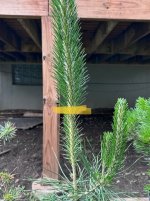BonsaixDad
Sapling
- Messages
- 28
- Reaction score
- 9
- USDA Zone
- 6b
I’ve had this skinny little fella for a few months, just been watering and fertilizing and clipping a couple buds here and there to prevent whirling. I know at this stage it is primed and ready for structural wiring, my main question to those of you who are experienced with these is, what do you do with all those thick long needles that are very much in the way??
Another question i have is what sport of pruning techniques if any should i be committing to? My plan is to maybe let the longest branch on the right be my leader, should i let the upright portion go on as a sacrificial leader? Or would it be best to just bend the hell out of the main trunk line. Basically looking for the quickest route to a healthy, thick and gnarly bonsai, maybe shohin style. Any and all tips and suggestions are greatly appreciated!
Another question i have is what sport of pruning techniques if any should i be committing to? My plan is to maybe let the longest branch on the right be my leader, should i let the upright portion go on as a sacrificial leader? Or would it be best to just bend the hell out of the main trunk line. Basically looking for the quickest route to a healthy, thick and gnarly bonsai, maybe shohin style. Any and all tips and suggestions are greatly appreciated!




